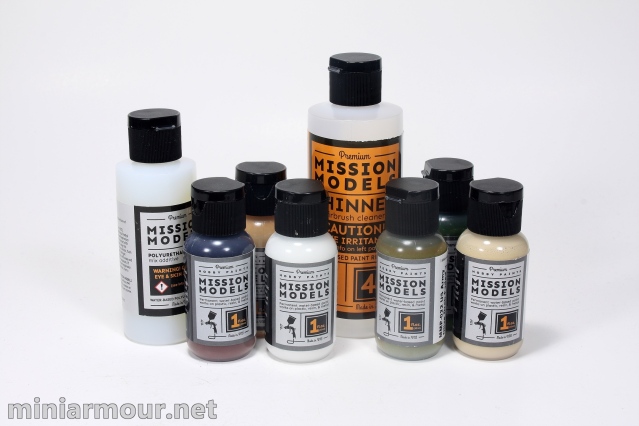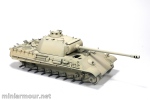
There are days when I ask myself, whether there is anything really new among the number of new products being brought to the market by the ever increasing number of suppliers. New kits, yes, no question about that. But when it comes to the modelling supplies, I have bit lost track of all the newcomer over the recent years. Paints, enamels, oils, washes, filters, you name it.
And there are days (like this Saturday) when you ran into your old friend (Ying) at the local model show (Torcan) and he just throws it to your face – “You should try this, great stuff…” The product in question was a small bottle of paint by a new company Mission models, of which I have heard before, but didn’t pay much attention to. To my detriment…
I decided to give the paint a try and got few bottles of different colors and thinner from my favorite supplier Hornet Hobbies, whose owner and friend Dave, gave me quick instructions on how to use it.
Now here I have to stop and say that since that start of my modelling years I was an ardent fan of Tamiya paints. In those years, number of new paint brands came to the market, but none of them seemed to work for me. Namely Vallejo/Mig/Ammo brands are offering series of paint products, which are widely used, but not by me. I had two issues with them. First, I never found a good product to thin them, so they always ended up clogging my airbrush. Second, somehow I was not able to replicate the ability to create thin transparent layers of paint that I could airbrush with the Tamiya paints. So I have quite a few of these paints, but they mostly sit unused on my shelf.
Here comes Mission models (MM). To keep it short – I love their paint! Here is why:
- Airbrushing quality – I gave the paint a quick try, namely the Dark yellow one and I found out it flows flawlessly. Thinned about 20-25% (3 drops of thinner for 12 drops of paint or 2 for 10), it airbrushes smoothly and without any issues whatsoever. Having added a drop of MM’s own polyurethane mix additive, which acts like a paint retarder and increases the drying time, I have achieved super smooth finish. This was one of my grievances with Tamiya paints – it is very easy to end up with sand-paper like finish, because the paint dries too fast. It can be fixed, but it is a hassle to deal with. Not with MM paint. I have put on a base coat of paint on my Panther and it was joy to work with the paint. I felt the paint was still bit more on the thin side, so perhaps could be thinned less, but I was able to achieve that opacity gradation and build up the final effect with multiple transparent paint layers.
- Packaging – here MM paints are on par with other new brands. Paints are conveniently sold in small plastic bottles with a small metal ball inside to mix the sediments if needed. Counting drops of paint straight into the airbrush paint holder is sooo much easier then mixing everything in small plastic cups beforehand.
- Selection of colors. My other grievance with Tamiya is that you always had to mix the shade of paint to use. I never got to use their paints straight from the jars, so it was always quite a bit of experimenting to get it right (or what I thought right). MM series of paints offer specific paints for German, Russian, Allied WWI subjects with the colors clearly identified in a way that makes it easy to pick the one I need – such as Dunkelgelb RAL 7028 late for my Panther.
- Now this one is more important than I would have thought – it does NOT smell. I have spent about an hour of airbrushing in my mancave and still could not smell anything. With the Tamiya paints, using lacquer thinner as I have been over the past years, was always difficult over prolonged period of time and required quite good ventilation.
- It cleans easily. Just use the thinner, once done painting, run the clear thinner few times through the airbrush and it’s fine.
So that’s it, I still have to try other colors from their range, but I will be heading over to the hobby store in the next days to get all the MM paint colors I need. And it seems that I will have to find some storage space for my quite large collection of Tamiya paints…
Categories: Slider, Techniques




I’ve used MM enamels most of my life, seriously, since I was a kid. I like the results, but they do smell bad, and now the color selection is shrinking.
I’ve tinkered with a few others, like Tamiya acrylics and Mr Color. But selection and availability at local shops has always been an issue.
Let us know how a bigger use of this works, it might be time for a change!
Glad you like the MM paint, l was skeptical at first as well after so many brands. It was the pass through the airbrush that sold me. To add Mike Rinaldi was the chief test for this paint and it was his added endorsement that said this was a quality product. Look forward to seeing seeing more as an aircraft, and automotive line of colours are soon coming!!! Vlad also thanks for adding me in your comments.
How are they for brush painting?
I just recently tried that and the paint works very nice with a brush. Like all paint it must be thoroughly mixed/agitated.
For those interested Mission Models has released more colours including gloss, satin,and flat finish.
Are you spraying the MMP over primed surfaces? My favorite paint has for years been Gunze Sangyo, and with that aggressive Mr. Color thinner you didn’t have to primer anything, it would just bite into the plastic. I bought several bottles of MMP, plus thinner, primer, poly, etc. and was tols it only works properly over a primered surface. Is that true? I definitely adds extra steps, extra airbrush cleaning, etc, and as I build a lot of 1/72 stuff, it’s obviously gonna build up a heavier coating on models with already very tiny and lightly etched details…just wondering if primer is an absolute must, thanks!
I use Tamiya aerosol primer,I then go the Vallejo or Tamiya Acrylics for the basecoats.
Hi Michael, I am always using primer. It give many advantages, primarily it provides better base for the subsequent paint coats, this increases resistance to abrasion, which sometimes creates problem when handling models. Primer also helps me to blend the surface, especially when using photoetch parts and helps me to spot any construction imperfections before I start painting. Applying the primer from spray can is actually super easy and definitely the fastest of the painting phases. The only concern is that it is better be done outside, which is not always easy in the winter here in Canada 🙂
I understand on smaller scales this may be more of a concern, but I am using Tamiya spray can primer and even with 1 or 2 light passes the layer is super thin, so I never had any problem with covering any fine details. Hope this helps, Cheers! Vlad